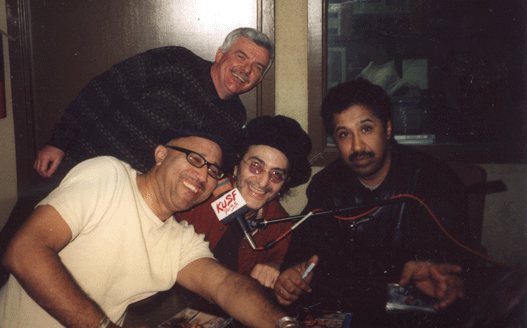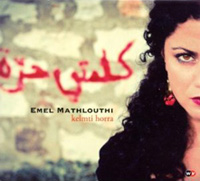
EMEL MATHLOUTHI
KELMTI HORRA (World Village wvp 479065)
I should have written this up two months ago because Emel launched her North American tour here in Berkeley and I was there with Big Steve to check it out. We had a gas but now it's a faded memory. Introducing her, her brother explained how this modest young lady had become known as "the Voice of the Arab Spring," but it has not gone to her head. She came without her band, sadly, because it was a low-budget "testing the waters" tour. Dressed like Joan Baez circa 1965 (in an embroidered Guatemalan?-shift), she proceeded to do a "Stars on 45" cover of some early Baez material with her guitar. Good thing I was wearing my Birkenstocks and socks. She did sing "We shall overcome" in Arabic, but for me the highlight was her acoustic cover of "White Rabbit" by Grace Slick, none of which are on her album. She was more intent on establishing her credentials as a singer-songwriter and staking her claim to her San Francisco musical roots. It must have been very surreal for her to actually be here after years in her bedroom in Tunisia spinning vinyl and imagining Haight-Ashbury. My radical historian pal Steve felt she should go to Oakland to see where Baez was first arrested. Mathlouthi's big breakthrough came at a liberation concert in Tunis where she was told beforehand NOT to sing the radical songs that had been electrifying the revolution. The producers called her brother aside and said, Tell her she can't sing those songs. He replied, Sure, but I am her brother, if I tell her something she will do the opposite! The CD is a whole other universe. It's a heavily produced affair with synthesized strings, bass thrums and electronic hums supporting it. Some of the production reminds me of Björk, for example her phrasing on "Stranger," sung in English. And the Baez influence is very evident in the title cut. Here's Mathlouthi performing that track, "Kelmti horra (My word is free)" from this disc, and "Ma Lkit (Not found)" on TV. Overall her debut is highly accomplished and bodes well for her career.
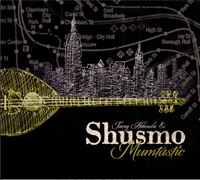
TAREQ ABBOUSHI & SHUSHMO
MUMTASTIC (Shusmo)
This comes out of left field and is a refreshing slice of Arabic groove meets jazz-funk. From the outset there are rock drums, a jamming stringed instrument (grunge bazouk) and a wild clarinet embroidering the melody. There is even a Latin tinge. Tareq Abboushi, the leader, explains that he finds people are either sitting down listening to classical arabic music or kicking up their heels to pop in a disco and there should be a middle course that has sophisticated playing with a groove, combining rhythm and melody. Abboushi plays the bazouk and also piano which he learned as a child in Ramallah and continued to study as a jazz instrument after he moved to New York. His line-up is complex: he matches the riq, or Arabic tambourine, with congas and timbales. There is a popping jazz bass as well as the unclassifiable horn player. Periodically they return to a feeling of classical Arabness, like "Interlude" and its sequel "The Wall." Or to the Western tradition, like on "Time it takes" which quotes Bach's Bourée in E-minor. It's a hybrid that really works. "Shusmo" is the Arabic for "whatchamacallit?" and the name of the album, Mumtastic, refers to "mumtaz" (=excellent) plus fantastic. I'll say.

RAMZI ABUREDWAN
REFLECTIONS OF PALESTINE (Riverboat TugCD1061)
It was a hard road to the top for Ramzi Aburedwan. He was raised in a refugee camp in Ramallah, on the West Bank in his native Palestine. His grandfather had lived his life amid orange groves in a village dotted with eucalyptus and other perfumed trees until he was forcibly evicted in 1948 to the poverty-stricken concrete jungle where his grandson was born and raised. As a child Ramzi threw rocks at Israeli tanks: he was lionized, but no David and Goliath triumph ensued. But then as a teen he took up bouzouk, a stringed instrument not unlike the Greek bouzouki, or the Turkish saz, and proved to be so proficient he was awarded a scholarship to study in France (His time there is celebrated in the tune "Bordeaux"). Thus music took charge of his passions and he now leads the Palestine National Ensemble of Arabic Music. This album is his own project, featuring his deft fretwork and accompanied by clarinet, oud, accordion, and two vigorous percussionists. It's a mellow, meditative set, emanating peace. There is an uptempo number called "Tahrir" in the middle. As we know from world events that is the Arabic word for "Liberation," but it's also the name of Ramzi's cousin who was intrigued by his instrument and soon took up violin herself. Ramzi's ideal of rebuilding Palestinian culture through music rather than aggression seemed to work here and he hopes his music will effect more positive moves like this.
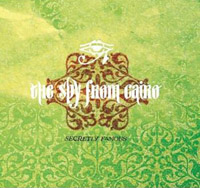
THE SPY FROM CAIRO
SECRETLY FAMOUS (Wonderwheel)
This is a collection of dance tracks from Arabia with diverse source material treated to electronica and a dubby sensibility. The album title is a bit of a joke because the Spy is Moreno Visini who has appeared on scores of DeeJay comps from BUDDHA BAR to the Zeb albums. But fame in the world of DeeJays is hardly front-page. The album kicks off in style with the high-pitched whining sound of the nay (a bamboo flute) blown at a Jordanian wedding, though it sounds like a wedding of snake-charmers. It is reminiscent of Arabic Groove, Michael Jackson as envisioned by Fellini, and indeed Spy movies! There's oud and darbouka (the traditional percussion) and Visini has added a dubby bass line to push it along. Because we think of arabic music as inherently trance-like it's a good mix of repetition and mood-setting themes. This one is likely to supplant Arabic Groove on the popularity front. It has the same diversity, from belly-dance to Sufi trance, & is just as catchy and compelling. "Kurdish delight" continues the nay theme, and the dub attack, with a breakdown to bass, drum loops and something that sounds like shorting-out wires or a sound-board on the fritz. Tunisian woman singer Ghalia Benali shows up for the first of four appearances on "Ana Arabi," a song about being an Arab, not a terrorist. There's a flat spot in the middle then things perk up with wild violin on "Leila." "Sufi disco" is a humorous name, because it's the spaciest track on here. You kind of forget where you are, until the bass and tambourine kick up a sandstorm for the next track, "Saidi the Man." This has wild flute and a cheap synthesized rhythm reminiscent of Bollywood soundtracks from the 70s. Then suddenly we are whisked to the Atlas Mountains by "Reggada," a very different sound with that dusky Joujouka flute emerging from a big cloud of smoke.
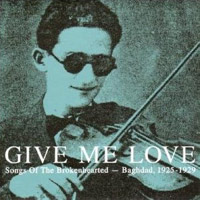
GIVE ME LOVE
SONGS OF THE BROKENHEARTED -- BAGHDAD, 1925-9 (Honest Jons HJRCD35)
In 1984 the former head of the secret police became dictator of a weapons-mad rogue nation while a long-unemployed actor slept through the role of president. Bush One, or Poppy, as this evil individual became known, invaded Kuwait on a pretext and bombed Baghdad. At the time I used to play an Iraqi song on the radio called "Everybody blames me." It was rather mournful and came from the only Iraqi album in my collection. Now, despite the depressing title, I bought this Songs of the Brokenhearted, because it was recommended by friends and also because it is the first in a new series of world music reissues from the Honest Jons label. I want to do my bit to encourage HJ and hope they get to Congo and Kenya and Tanzania and Madagascar before they decide it's a lost cause. Honest Jons has made a deal with the EMI Archives which is now a non-profit foundation, and plans to issue a series of historic recordings. Harlequin already raided the EMI archives for some Cuban recordings in the mid-1990s.
The Gramophone & Typewriter Company was formed in 1906 and built a plant in Middlesex, rural England. As Nigel Williamson reports, in Songlines, they bought out the local chicken farmers so that the clucking of hens would not be picked up in their studios. As the company opened branches in the rest of the world they encouraged local managers to record anything they thought might sell and send it back to the head office for pressing. Hence their archive is a treasure trove of a century of recorded music, much of it the earliest known recordings from particular regions. Their first engineer started out with Emile Berliner, inventor of the gramophone, before moving to England to begin a distinguished career, recording Enrico Caruso & Elgar. Nipper & his phonograph soon became part of everyone's living room furniture. Working class kids from Glasgow (like my mother and her sisters) could sing Donizetti arias in faultless Italian from listening to Tito Schippa.
The story of popular music in Baghdad is complex. Strict Mohammedans of course are opposed to anything as harmless as singing a song. The only women who sang were prostitutes and it was part of their act so they did not study. Musicians were mostly Jews who fled in the 1940s. At the time of the introduction of the gramophone Iraq was under British control. The currency was the rupee as Britain had plans to make Iraq part of India. So Hindi music was popular as well as military brass bands, and of course Egyptian superstar Oum Kalthoum. A few traditional arab instruments and musical forms, like the maqam, came from other parts of the arab world. The records made encompassed folk songs as well as contemporary songs, a Hebrew hymn and Kurdish and Bedouin improvisations as well as tunes from Bahrain and Kuwait. This compilation is a mosaic of the Middle East two generations ago. Zithers, violins, ouds, flutes back the mostly male singers. Varied and engaging.
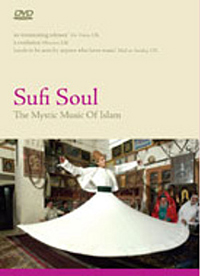
SUFI SOUL: THE MYSTIC MUSIC OF ISLAM (Directed by Simon Broughton; TUGDVD001)
This is an exemplary documentary that tells the story of Sufi music, the mystical outsider of Islam. The hardline mullahs, the ones we all know and hate, want to banish music. I think they would ban women too if they didn't need to procreate. They are clearly the most miserable bastards on the planet. (Because of the natural laws of balance they must exist as long as we have our own fundamentalist Nazis like BushCo throwing their weight about.) However from adversity comes strength and beauty. You know that Robert Burns was the best-selling poet in nineteenth-century Britain? Well, in 1990 the best-selling poet in the USA was Rumi, the 13th-century Afghani mystic, with his message that love is the surest path to the Divine. Sufi singers generally take a well-known verse from one of their famous poets and then improvise. Nusrat who appears fleetingly here, did this like no one on earth. We also see and hear Youssou Ndour at the Festival of Sacred Music in Fez, Nusrat's nephew Rahat Fateh Ali Khan, and Abeeda Parveen as the camera follows William Dalrymple, who has lived in south Asia for two decades, from Pakistan to Turkey, Syria, & Morocco. Dalrymple is a scholar who sees Sufism as a peaceful bastion against fundamentalism. The film opens with a stunning performance by Sain Zaheer and his bluesy banjo-like dirge, his bare feet stamping to jingle his ankle bells outside a Pakistani saint's tomb. The camerawork is exceptional and so is the editing. It is a treat to see such a well-made film about something so precious and evanescent.
I had a little religious epiphany recently. My satellite dish unlocks random world TV channels so for a fortnight I had the Sikh channel and they have a live show called "Gurbani from the Golden Temple." As it was on endlessly I would often tune in when I woke up or was falling asleep and soon found myself checking into it regularly. There were three fixed camera shots: Outside the surprisingly tiny Golden Temple in Amritsar, a large manmade lake or cooling pond, and birds flying over. You could see what time of day or night it was and occasionally pilgrims cooling their toes or queuing to get into the temple. Inside the temple there was a shot of the priest who sat before a silk-draped altar adding or removing layers of fabric, occasionally waving a large white fly whisk slowly over it. And the third shot was the band, two harmoniums, tablas and singers crammed in a corner. Behind them was the door so you saw pilgrims entering and leaving & making obeisance to something off-camera. It was fascinating. While the music was a constant and some singers were better than others it was the slow, almost static quality of the events that kept me rapt. It was so immediate in a funny way, despite being halfway around the world, it was the here-and-now. I watched a nasty rich housewife elbow a big praying man so he moved out of the spot she wanted. The priest finally got to the bottom of the pile of silk and there was a giant book! That was a great moment, but he quickly started covering it again. Though I am deeply irreligious I see its uses. Sufism has a palpable effect in the whirling dervishes, who whirl so slowly they should be called perhaps the revolving dervishes. In Lahore the devotees whirl a bit more vigorously to attain waj, or ecstacy. This is probably more what it was like in the 13th century, Dalrymple tells us, easing from the wild bhangra dhol drum to qawwali and a sample of Nusrat doing "Allah hoo." DVD extras include full performances by Turkish ney player Kudsi Erguner, Sain Zahoor, Nusrat's nephew Rahat Fateh Ali Khan, the Bhitshah Fakirs who play six identical stringed instruments, and Morroco's Rokia Riman Jilala Band.
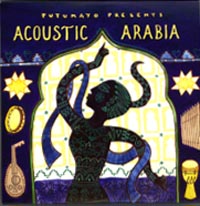
PUTUMAYO PRESENTS ACOUSTIC ARABIA
The popular compilations that Putumayo, Rough Guide, Nascente, Union Square, and other labels put out are an interesting sub-genre of music. Usually, if I know the field, I am critical of their choices. The selectors are limited by what's available for licensing and also the need to have a few name acts or popular hits to entice the buyer. The less-well-known areas tend to be more interesting to me because Jacob Edgar at Putumayo or Dan Rosenberg at Rough Guide have waded through the chaff for me. When I saw Jacob's music room in San Francisco lined with promo CDs many years ago I wasn't jealous, I pitied him having to spend real time listening to marginal music to see if it makes the cut. Putumayo has put together many intriguing slices of the musical continuum from across the globe. Their North African Groove, Turkish Groove, and Arabic Groove are superb sets. Their takes on Brasil and Puerto Rico, Colombia and the Dominican Republic deserve to be taken seriously, even if the pathetic covers, featuring vapid we-are-the-world art, suggest otherwise. IJ is always urging me to give more than a cursory listen to new product, but if a friend sends me an old Star Band de Dakar album or I decide to listen to ALL my Derrick Harriott with a view to making a Crystalites compilation, then I get sidetracked for days and the Putumayo promos edge closer to the free box. Which is a roundabout way of saying I finally gave the ACOUSTIC ARABIA CD another listen and decided it's okay. It starts strong with "Gamar Badawi" by RAS, but goes off into French cafe music which is why I got impatient, and there are a lot of artists on here I have listened to and given up on who are good for a song or two 'til I get restless and change the music. "Azara Alhai" by Rasha is the next good entry then we hear bits of Flamenco, pop/rock, and who-knows-what-all till we get to Souad Massi. The Souad Massi song "Ghir Enta" is a bona fide hit, so it's good to have it collected here. Also the album gets stronger as it goes on and the big guns, like Massi and Maurice el Medioni are saved for the end. El Medioni is a Jewish piano player from Oran who has Boogie Woogie and Cuban jazz under his belt and is pound-for-pound the most accomplished musician on here. But then we are derailed again by the last cut. A friend who lived in North Africa for years said it's the kind of music played in fancy bars where rich Arabs take their mistresses. It may be that the future of these compilations is circumscribed because now you can sample the tunes on Amazon or iTunes and just buy the ones you want. But do check out El Medioni.
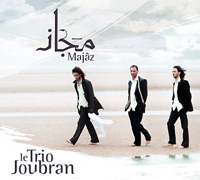
LE TRIO JOUBRAN
MAJAZ (Randana RAND002)
The Palestinian oud Trio Joubran returns with another set of dreamy improvisation on the maqãms written for the ancient strings. It's classical though only one track is drawn from the traditional repertoire; the others are all originals. The title means "metaphor," which they define as "the meaning of meaning," and they are inspired by the Palestinian poet Mahmoud Darwish. There is gentle percussion accompaniment but otherwise the clean mellow sound of the ouds. Each of the brothers gets to do a version of "Tanasim" as a solo: Adnan is dramatic; Samir is talkative; Wissam, the lutier of the family, is poetic. The tracks are short and sweet. When they jam together, as on "Sama-sounounou," the results are incendiary. This is another wonderful album from these lads, and the beauty is they are touring to support it, so check their website for venues. (Doesn't the cover remind you of ABBEY ROAD?) While they were on tour behind their first album, "Randana," the bloody Israeli army bombed their home, so they must be happy to have a life on the road.
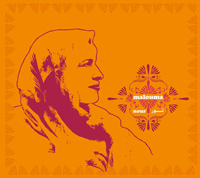
MALOUMA
NOUR (MARABI 46819 2)
She has been called, rather blithely, "The Blueswoman of the Desert," but Malouma is much more than that. She has struggled for female emancipation in her native Mauretania. Since her first album DUNIYA she has continued to improve. Malouma's third international release is called NOUR. You may not have heard of her or even noticed her, because her album packaging is so abysmal. In 1998, Shanachie issued DESERT OF EDEN, produced by Pape Dieng at Studio 2000 in Dakar. The session men included Oumar Sow on guitar and Thierno Kouyate on sax. The first track, "Ya Habibi," was anthologized on a box set (WORLD DIVAS, I think) and it was from there that British DJ Charlie Gillett gave it several plays. It resurfaced on a Shanachie anthology called HOLDING UP HALF THE WORLD, which featured African artistes.
"Ya Habibi" is a standout track for me, and I wish the Senegalese musicians had been allowed more of a free rein throughout, as some tracks strike me as mannered. There is a version of Otis Redding's "Fa Fa Fa Fa" with Mauretanian lyrics: "Pardon my sins both old and new/ Yesterday and today/ I pray for the day/ when death will come / &c"! Significantly, several tracks are re-worked on DUNYA, and this might indicate that this first effort has been "disowned". Invited to the Festival des Metisses in Angouleme, she went into the studio with a hybrid band and produced this fine album. There's desert blues but definitely a global sensibility with some superb session guys dropping in the right amount of synth, bass, samples, whathaveyou. Yes, there's familiar rock elements but also an air of mystery with the Mauretanian instruments on her side. Malouma plays a ten-stringed harp and sings with a guttural edge that sounds abrasive, but she can also sound soothing. Bojan Z plays a Fender-Rhodes "Xenophone" -- a modified keyboard I guess-- Loy Ehrlich plays Gumbass, a cross between an electric bass and a Moroccan guimbri. Guitarist Pierre Fruchard has been listening to Jimmy Page and the atmospherics are by Tunisian-born Smadj. There are some fine harmonies and light pop touches which the Duchess dismissed as "wimpy." It gets quite bluesy for a spell then suddenly a very credible reggae number called "Casablanca" mashes it up and reinvigorates the set. Shades of King Tubby and flying cymbals in the mix! Overall the impression is of a modern sensibility without losing touch with the ancestors. In that regard I think this is a bold and interesting effort. In a side note, Mauretania held its first democratic elections this year, March 2007, since independence from France in 1960, and Malouma was elected to the Senate.

NEMA MINT CHOUEIKH
MAURETANIAN MUSIC FROM THE TRARZA REGION (PAM oa 211)
Günter Gretz is a determined individual. Most of us, on hearing a great piece of music in a film, might wait till the end and read the credits to see who the artist was and, if we remembered later, try to find their music on-line or at a record store. Gretz however is out-of-the-ordinary, not least in the movies he goes to. The movie he was watching was En Attendant le bonheur by Malian director A. Sissako & the moment that made his hair and ears stand up was when Nema Mint Choueikh was teaching a young girl a traditional song. It just so happened that in 2003 Gretz was driving through the town of Noaudhibou, in the Trarza region of Mauretania, where the film was shot, on his way to Senegal. He inquired and was told the singer lived further along in another town but when he got there he found he had passed her house on the road long before &, as he had an appointment in Senegal, he couldn't turn back. A year later he was back in Noaudhibou and learned there was to be a music festival with Nema performing one week later, so he returned to catch her act and hopefully hook up with her. Again her voice sent shivers down his spine, but as soon as she left the stage she got into a limo for the airport and a flight to Paris. He left a message with the concert promoter and 14 months later was back to finally meet Nema and record her. But at this point a sandstorm was brewing and the tin rooves of the houses were beginning to rattle ominously but, undaunted, Gretz set up his recording equipment and went for it, working for 3 hours to capture Nema and her ensemble performing for this CD release. It is traditional Moorish music. Nema sings and is accompanied by hand-claps and a couple of thwocking string instruments, the tidinit a small hour-glass shaped lute with five strings, and a kora-like instrument, the ardin, which is played by women. Sometimes an acoustic guitar can be heard, but the bending notes of the ardin are most unusual like it's constantly being tuned, while the tidinit embroiders the melody like the Manding ngoni. There is also a deep drum called the tbal. Between the songs the musicians do indeed tune-up so the music doesn't stop, it just goes into a lull of very out-sounding noodling for a few seconds between tracks. While the concert is acoustic there is one interesting note. A bullhorn is used (it can be seen on the cover), not for singing but to pick-up and amplify the guitar and tidinit. It sits on the ground next to the pick-up of the instrument and can often produce wild Hendrix-esque distortions. This is a wonderful recording and a window into a traditional world that is of course rapidly shrinking. Gretz promises if people buy this album and support his label, instead of copying it and ripping him off, he will release an album of electric guitar & tidinit music from Mauretania next.
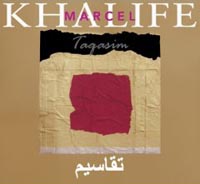
MARCEL KHALIFE
TAQASIM (Nagam Records/Connecting Cultures CC50034)
"Taqasim" means improvisations. This tripartite set of long meditations by oud player Marcel Khalifé is poetic and a bit melancholy. The accompaniment is spare: percusion and an acoustic double bass (which I think is unusual in arabic music). Khalifé is Lebanese. The sound is ancient and reverberates with the history of arabic music. I even hear echoes of Moorish music from the other end of the Mediterranean and about seven centuries earlier. In the liner notes, Khalifé explains that he was inspired to create this set by the poetry of Mahmoud Darwish, the renowned Palestinian lyric epic poet. But there is no human voice on the recording, no poems printed in the booklet. It's the memory or thought of Darwish's poems, imagined in his voice, that moved Khalifé, and his playing is an expression of those vocal inflections he remembers. This experiment works well, as it did for John Coltrane, whose tune "Alabama" was composed while listening to a speech of Dr Martin Luther King, Jr. You can hear Darwish reading here.
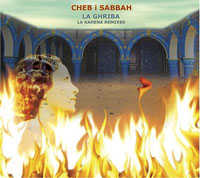
CHEB I SABBAH
LA GHRIBA: LA KAHENA REMIXED (Six Degrees 657036)
It's an inevitable as spring follows winter, or around here, winter follows spring... the Remix album. The latest from the Young Man of the Mountain is a set of oldies in a new galabieh: Cheb i Sabbah gave his raw material to some other master mixologists and like a chain letter they sent back their take on his latest set of tunes. I asked him whether the artists were all people he knew or did they work independently and then send him the results. He knows all of them, he says, and they mostly wanted the original "dry" track, without any of his own effects or add-ons. But this is quite easy, he tells me, with the technology that is used today. "A couple of people took little sections and built up a whole structure but all they wanted was a snippet." I asked him about the distribution of songs since obviously the most catchy tunes would be most popular. "Toura toura" and "'Esh dani, alash mshit" were the most popular. The latter, which was remixed by Temple of Sound and Bill Laswell, reminds me of "Truckin" by the Grateful Dead, I told Cheb i, as it has a catchy refrain that keeps chugging back. "Maybe I could get one of the Dead guys to remix it, he joked, then I wouldn't have to worry about the rent!"
Moroccan artists Ahderrahim Akkaoui and Pat Jabbar, known as Dar Beida 04, picked the hardest song, he tells me, and came out with a trance vibe. (Dar Beida is the Arabic name for Casablanca.) "Not many venture the hardest tracks: if it's more catchy they think they can do something with it. Bassnectar wanted to do 'Alkher illa doffor' which was cool because no one else wanted to do that one. If you like break-beats it works." We talked about remix albums in general. He told me so many sound the same. "It sounds like Logic," is a deejay in-joke because of the beginners who let the inherent sound of the software dominate the result. Cheb i Sabbah likes the latest from Bally Sagoo and thinks he did a fine job trying on different styles, like House, but he doesn't like Balkan music because the brass instruments grate on him, so he didn't get into ELECTRIC GYPSYLAND which was my top album last year. We also differ on Bally Sagoo, whom I find very inconsistent. "The big names were cool at first but then the interns took over, and so often it shows," he says, referring to the stratosphere of remix jockeys. On LA KAHENA REMIXED, he says, "There are 11 remixes here but 11 different kinds of sounds. Each track has an individual sound, so I was happy overall. I am not expecting everybody to love the trance tracks and the break-beats, but overall it represents pretty much the dance scene as of today. -- Well, there's no House, but who needs more House?"
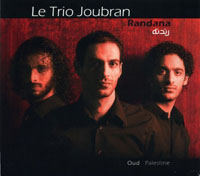
LE TRIO JOUBRAN
RANDANA (Fairplay 500 Harmonia Mundi LC11983)
Here's oud music from Palestine, performed by three brothers from Nazareth. One oud is beautiful and three, while unusual, are quite stirring when played together. The result is sensual and soothing, making you wonder how they practice with all the madness and mayhem in their country, and where do they perform? I suppose life must go on, perhaps even mundanely so, despite what you see on the news. (I was in Belfast the morning after the IRA blew up the Law Courts and no one was much bothered.) There are five tracks here, four recorded in the studio in Jerusalem, the fifth live in Ramallah with vocals and an audience sing-along. Art is such a fragile thing to hold on to in these violent times. Try not to think of the hole the Palestinians have dug for themselves by expressing their democratic will & electing the people they see most fit to guide their future, after decades of compromise and loss of face (as well as life) while the fascists in Israel snap at their American masters & ignore the censure of the world in their murderous folly. An Israeli told me they are so desperately arrogant because they think inevitably the Arabs will prevail. Enough of that. Listen to this album in the evening when you are unwinding. Who knows what tomorrow will bring? Rosebuds are gathered and presented in an alchemical musical mix. Samir Joubran, the eldest, is hailed as a master oud player in the Arab world. He and younger brother Wissam recorded TAMAAS in 2003. Then a year later their youngest brother Adnan, only 20 but considered a prodigy, joined the group. The longest track, "Safar," (perhaps it means journey) starts off with a slow arpeggio while a second instrument sets up an ominous vibrato, eerie in a cinematic way. After a long digression it returns to the theme but then fades out, suggesting they were just jamming in an endless take. The music is drawn from the traditional maqam repertoire which allows them room for exploration and innovation.
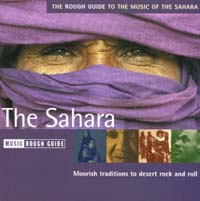
ROUGH GUIDE TO THE SAHARA (RGNET1153 CD)
Now here's a truly rough spot for adventure travel. Despite the vastness of the Sahara and its generally unforgiving climate, it has attracted more and more travelers as the annual Festival in the Desert attests. I love the African desert: you can sleep on the ground under the vast starry heavens and there's no bugs or insects to pester you; there's beauty in the landscape (like acres of semi-precious-looking stones that you pick up and then drop when you can't carry them further), as well as surrealism (bones, decayed abandoned things). The sand makes a great bed. The nights are cool, cold even, but the days are filled with thoughts of water and how much you have. By all means drink the mint tea strangers will proffer you but don't eat the dates: they've been handled so much they carry staph infections! Assuming you don't get lost (as I did in the Nubian desert for a few panic-stricken days), take time to enjoy the music of the Nomads. This wonderfully crafted compilation starts with Andalusians melodies from the farthest Northwestern stretch of the continent and criss-crosses the Sahara like a crazy caravan in search of sound. There's traditional Tuareg music on here alongside wild rock 'n' roll, and many things in between. Tartit, Tinariwen and Malouma are the only familiar names, but the others are equally compelling and this is a top-notch assembly. There's a group of three songs in the middle of the album highlighting the Sahraoui of what was called Spanish Sahara, an area now under attack from Morocco who claim it as a contiguous bit of their own fiefdom. Nayim Alal's "Bleida" has very "out" guitar and one of the most unusual things I've heard in a long time. It starts with great promise but degenerates into a Jethro Tull rave up betraying the Brit roots of the compiler. A blend of tradition and rock is achieved by Mariem Hassan on "Id Chab": her singing seems untainted by outside influences, but the guitarist has been listening to "Run thru the Jungle" by John Fogerty. Seckou Maiga is tipped as an up-and-coming Songhai artist to watch. He turns in a desert blues that is the most familiar-sounding thing on here. Kel Tin Lokiene are reprised from Festival in the Desert with their thudding "washing-machine" sound. Things go out peacefully and gently into the night with the gasba blowing its hot breath into the dunes under the plaint of Sahraoui Bachir.
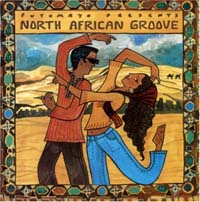
PUTUMAYO PRESENTS
NORTH AFRICAN GROOVE (PUT 237-2)
NORTH AFRICAN GROOVE picks up where ARABIC GROOVE left off: another set of great Casbah-rocking jams. ARABIC GROOVE stands as one of the best sequenced and consistently great compilations ever. NORTH AFRICAN GROOVE falls just below. The centrepiece is Khaled's "Ya Rayi," and everyone else ebbs and flows around it with the same metronomical insistence. But thankfully, it's not all techno: Amr Diab from Egypt has traditional instrumentation with a "Gypsy Kings" feel to the flamenco guitar which, in this context, is not unpleasant. French-born Rai singer Faudel does have synths but at least one of them is set to "accordion" mode. He's keeping Algerian music vital in the Paris suburbs. The cat-like mewing of one of his keyboards is overridden by the great slappy percussion. Amina who moved from Tunisia to Paris and became a star in 1989 with an entry in the hokey Eurovision song contest, gives us one of her solid hits "Dis-moi pourquoi," with a solid bass thwock. There's funk from Cheb Mami and disco from Mohamed Mounir, the Nubian Nut, on here. Mounir is from Aswan and apparently influenced by reggae but this is straight disco dance redeemed by the segue into the last track by Eastenders, a deejay from Germany who collaborates with Turks and Egyptians for a trans-Euro sound. "On the ride" is one of the strongest cuts on here, and bound to get you moving and grooving. Play it back on the track, Jack!
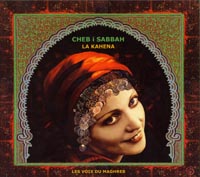
CHEB I SABBAH
LA KAHENA (Six Degrees [catalog number too small to read])
Cheb i Sabbah has gone home to Algeria and is doing what he does best: finding great music and kicking it up a notch with his self-assured mixing. After tooling around the Indian subcontinent for a few years (& producing SHRI DURGA, MAHA MAYA and KRISHNA LILA), the venerable Chebi-ji (he should be about to graduate to Pir i Sabbah, if not Hassan, any day!) pops in on some North African & Middle Eastern lady singers and comes up trumps! Actually in track four they mention Hassan i Sabbah (The "Old Man of the Mountain" you remember from Max Fleischer Studio cartoons!). I suppose the association is unavoidable. Hassan was a famous Islamic rabble-rouser and it is from his opiated devotees, the Hashishim, that we get our modern word "assassin." But Cheb-i is only out to slay us with a killer mix, & he succeeds on this outing. It's a soundscape or aural tour of North Africa, with street sounds in addition to the deftly layered music. Although he's a master mixer, this is not a dance set: it is in many ways a folkloric recording, though of course there are modern instruments on here. But then Rai music is itself a hybrid form that took to synthesizers and drum machines like a duck to stale bread. But Sabbah brings an urbane eye to the traditions, and he manages to keep the "world beat" slacker community happy by introducing Bill Laswell, Karsh Kale & Co., but the best part, for me, is you don't even notice them!! He's doing a fine job keeping them on a leash.
Because of the strife in his homeland, Sabbah recorded in Morocco, and brought in musicians from many traditions, Berber, Jewish & European, as well as Arabic. So the Women of Marrakech (B'net Marrakech), who normally do weddings and henna parties, appear alongside big-name dames like Cheba Zahouania, who opens singing "I got some shit!" -- or that's what it sounds like to me. But it's the third track, "Toura Toura" that opens up the vista for me as thudding bass (Bill Laswell, really?), handclaps, and those metal clackers called krakebs set up the groove for Gnawan singer & guimbri player Brahim Elbelkani. We are ready for trance time now. (This tune appeared on the great 1990 Moroccan NIGHT SPIRIT MASTERS album which Laswell was also on.)
"Im Ninalou (The doors are locked)" was previously on Michal Cohen's HENNA album, but I recognize it from Ofra Haza's 1988 hit. "Im Ninalou" has a dance beat that guarantees it a place on the next Putumayo Arabic Groove compilation. Though Cohen's Yemeni, it sounds Egyptian to my infidel ears. It's the most melodically transparent piece & stands in contrast to the brusquer harmonies of the Sufic chanting on Haddarates' "Madh Assalhin," which Sabbah treats with echo and washes of synth approaching a "Paul Horn at the Taj Mahal" ambience (or I could be kinder and say Stuart Dempster in Cologne cathedral), but this praise song soon kicks into a groove before metamorphosing again with crisp tablas and Nercan Dede's nay.
Track 6 is a medley of pieces first recorded in 1997 by Steve Shehan and now reworked with bass & drums and layers of voices for a great trance-inducing 8 and a half minutes. The album ends with a lovely 13 minute meditation that brings up the plangent sounds of the derbouka, riq and qanun, and conjurs up the cool chaharbagh, or rippling waterfall, in the shade and the smell of orange blossoms, honey and kif on the breeze.
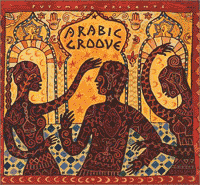
VARIOUS ARTISTS
ARABIC GROOVE (Putumayo 189-2 CD)
If you want to know what's rocking the kasbah these days, ARABIC GROOVE is where to start. From Algeria, Morocco, Egypt an other Arab countries we hear the dance-floor grooves and detect the influence of Western pop, notably funk, hip-hop and electronica. This of course makes sense from the Arabic point of view as those artists now get played alongside Westerners.In 1996 Khaled had a number one hit in France with "Aisha" and since then groups like alabina and Natacha Atlas have further popularized Arabic music. In the club scene there's Tranceglobal Underground and others.This album kicks off with a new single by Abdel ali Slimani, noted frontman for Jah Wobble's Invaders of the Heart. There's no space between cuts so you really get the sense of a programmed sequence for the dance-floor.
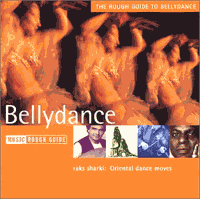
VARIOUS ARTISTS
THE ROUGH GUIDE TO BELLYDANCING (Rough Guide RGNET1066 CD)
THE ROUGH GUIDE TO BELLYDANCING subtitled "Raks Sharki: Oriental Dance Moves" is a delight for new and old ears. Even if you are hip to the sinuous melody lines and propulsive percussion that goes along with bellydancing, you'll dig this new compilation by Salah Miller. "Raks Sharki" is Arabic for "Middle Eastern Dance"; the term "bellydance" comes from a mis-hearing of "Baladi" meaning country. Locally (in San Francisco) it's known as "Tribal dance." At the 1893 World's Fair in Chicago, a dancer called Little Egypt brought shocked and delighted onlookers by the thousands and soon her dances were being imitated in vaudeville and burlesque. The fake "Oriental" costumes donned by American dancers made it into Hollywood and ultimately, from American films shown in Egypt, the Westernized version of the spangles and bangles was adopted into the tradition.
Watching my daughter-in-law dance with her troupe, Tabu, at the SF International Ethnic Dance Festival a couple of years ago, I realized that the good dancers are performing for each other, knowing the subtleties are lost on the audience. There is amazing isometric skill and muscle control. It's turns out more spiritual than erotic.
Mahmoud Fadl's epic drum set "Aament Beliah" (from the poor neighborhoods of Cairo) goes off into a 12-minute trance. The full-scale Andalusian orchestra of Ahmad Fouad Hassan is a trip deep into the Arabian Nights: "Dimashq" refers to the capital of Syria, Damascus. "The Happy Sheik" from Rabih Abou-Khalil's "The Sultan's Picnic" has a wonderful trombone solo. You hardly hear the oud; the liner notes tell us Milton Cardona plays conga on this track. The set shifts seamlessly around the Mediterranean through Lebanon to Turkey. Two of my favorite pieces are the Sufi-trance suggestive "Laz" from Omar Faruk's Tekbilek (I think that's him on woodwinds) and the next cut, "Kirkpinar Çiftetellisi" by Kemani Cemal Çinrli, from his album "Sulukule." This latter slow piece has an echoey violin playing over a ponderous drone and solid four-on four-off beat. Mahmoud Fadl returns for a heavy instrumental dirge with a tango-like beat and flying fingers percussion. Whatever Rough Guide's modus operandi is, they are certainly doing it right, and can be counted on for the inside track on world music.

JALILAH'S RAKS SHARKI 6
IN A BEIRUT MOOD (Piranha PIR CD 1788)
Oriental dance, mistakenly called "Belly dance" in the West, is actually known as Raks Sharki in the Middle East. Jalilah is a famous dancer and this CD presents her orchestra doing their thing. Without the distraction of watching the dancer (use your imagination) you can really get into the rhythms. There's a huge band, including six violins, piano, bass, cello, oud, kanoun, nay, percussion, accordion and chorus. The repertoire is original with one track drawn from the folklore of Lebanon. Hip-swivelling fun, and a must for fans of the genre.
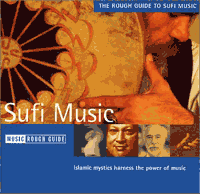
ROUGH GUIDE TO SUFI MUSIC
(Rough Guide RGNET1064 CD)
I had elective laser surgery on my eyes in June 2001 and spent 24 hours sedated in the dark while the anaesthetics wore off and my vision slowly returned. In my subdued-for-once state I decided to listen to Sufi music and the new ROUGH GUIDE TO SUFI MUSIC was to hand. It starts modestly enough in Turkey with a classical piece composed in the nineteenth century: a good introductory dirge, while we imagine the dervishes assembling. Sufi music was traditionally performed at religious sites, such as shrines, and in addition to the dervishes, members of the audience often go into trance and have to be brought round with verses from the Koran. Twenty years ago I saw dervishes in Omdurman performing in what was essentially a cemetery near the Mahdi's tomb. They whirled up a storm. Though frenzied, there's a stillness at the heart of the sound, in the breath of the flute or singer. A lot of Sufi music uses classical poetry as lyrics and it's easy to get into it as an accompaniment to reading Rumi or Kabir, both of whom are widely available in English translation.
After the Sabri Brothers from Pakistan and a taste of Egyptian religious singing ("inshad dini") we get a second Egyptian Sheikh, Yasin al-Tuhami, who cuts loose with "Alam" -- after a suitably reverential build-up on a scratchy lute.
Old hippies known the Gnaoua because of the Marrakesh connection and Hassan Hakmoun is one of the best-known exponents of this type of Moroccan sufism. In a track from "Gift of the Gnawa" with his long-time American collaborator Adam Rudolph on tabla, the brittle, limpid percussion gets your body moving, while Hakmoun puts the rest of you in a trance with stoney flute and vocals helped into the aether with one of my favourite toys: the Roland Space Echo. This is music to placate spirits and it sure made mine mellow.
After Abida Parween comes another gem: Ostad Elahi from Iranian Kurdistan on the sacred tanbur, the ancient Persian lute. His virtuosity is apparent, and I was reminded of Ravi Shankar. Not to slight West Africa, the compilation (which is extremely well sequenced) next offers up some mystical ritual drumming from Senegal, by Boubacar Diagne and drawn from TABALA WOLOF. Back to Egypt for a blind singer accompanied by flute and a trip to the lush sound of Damascus with another long slowly building piece on dulcimer, and we are nearer to enlightenment. Of course the best is last and that's Nusrat Fateh Ali Khan. Fateh by name and fatty by nature, he brought Pakistani qawwali music to young people worldwide and made his simple brand of devotional music very hip. There's no doubt that Nusrat had one of the greatest voices of the twentieth century, and set off against the simple harmonium, tabla and hand-clap backing it soars close to heaven.
